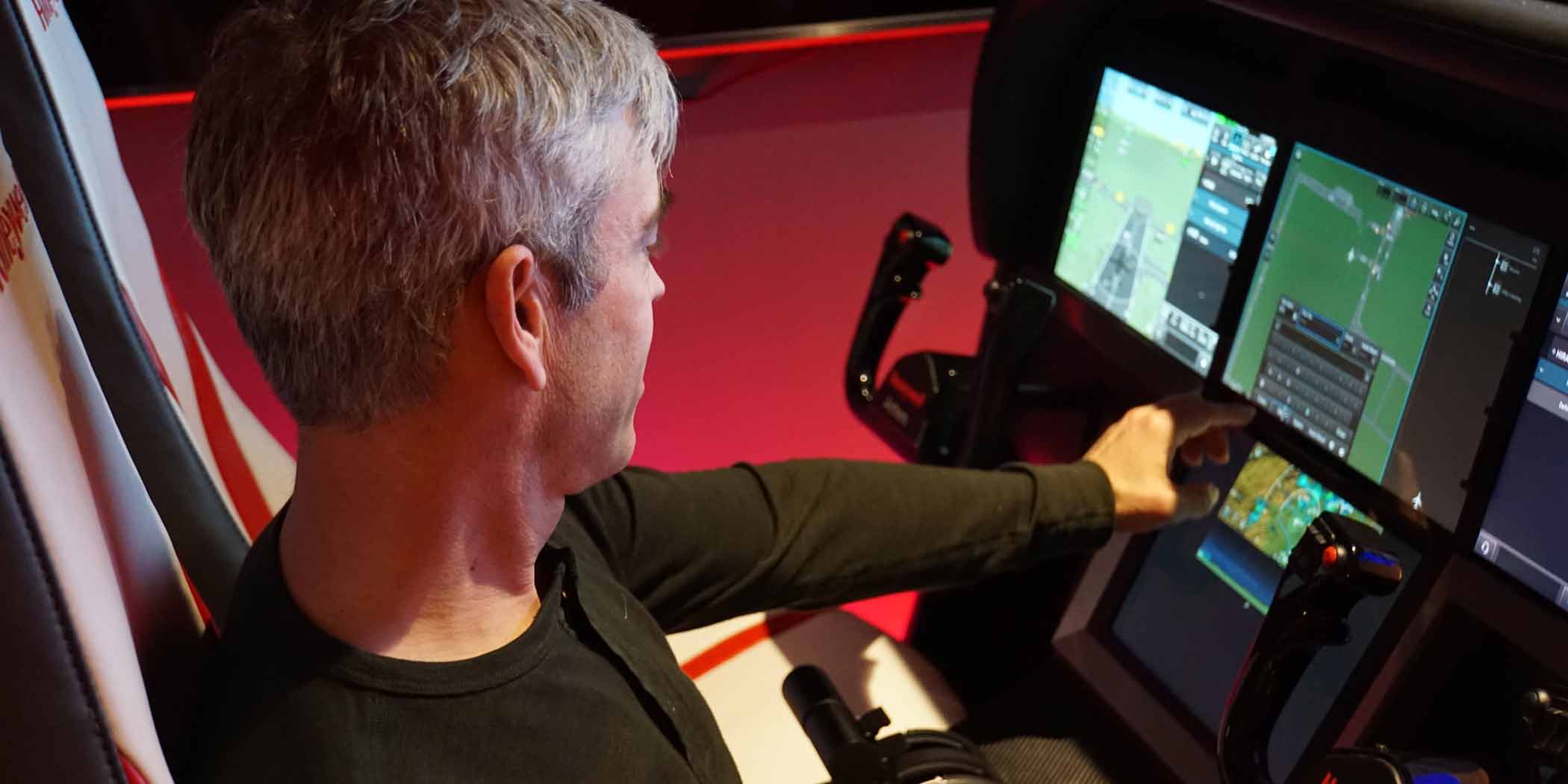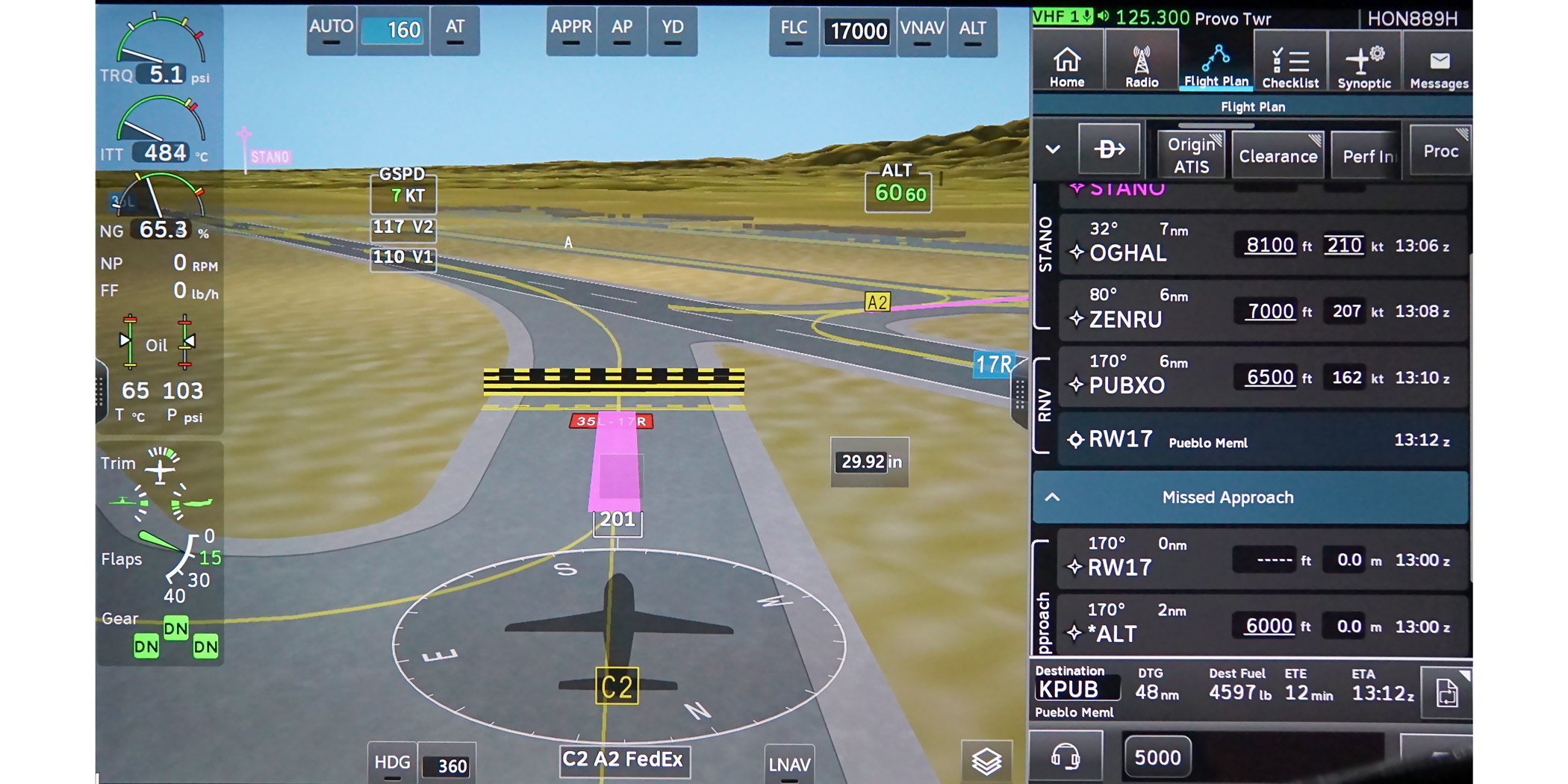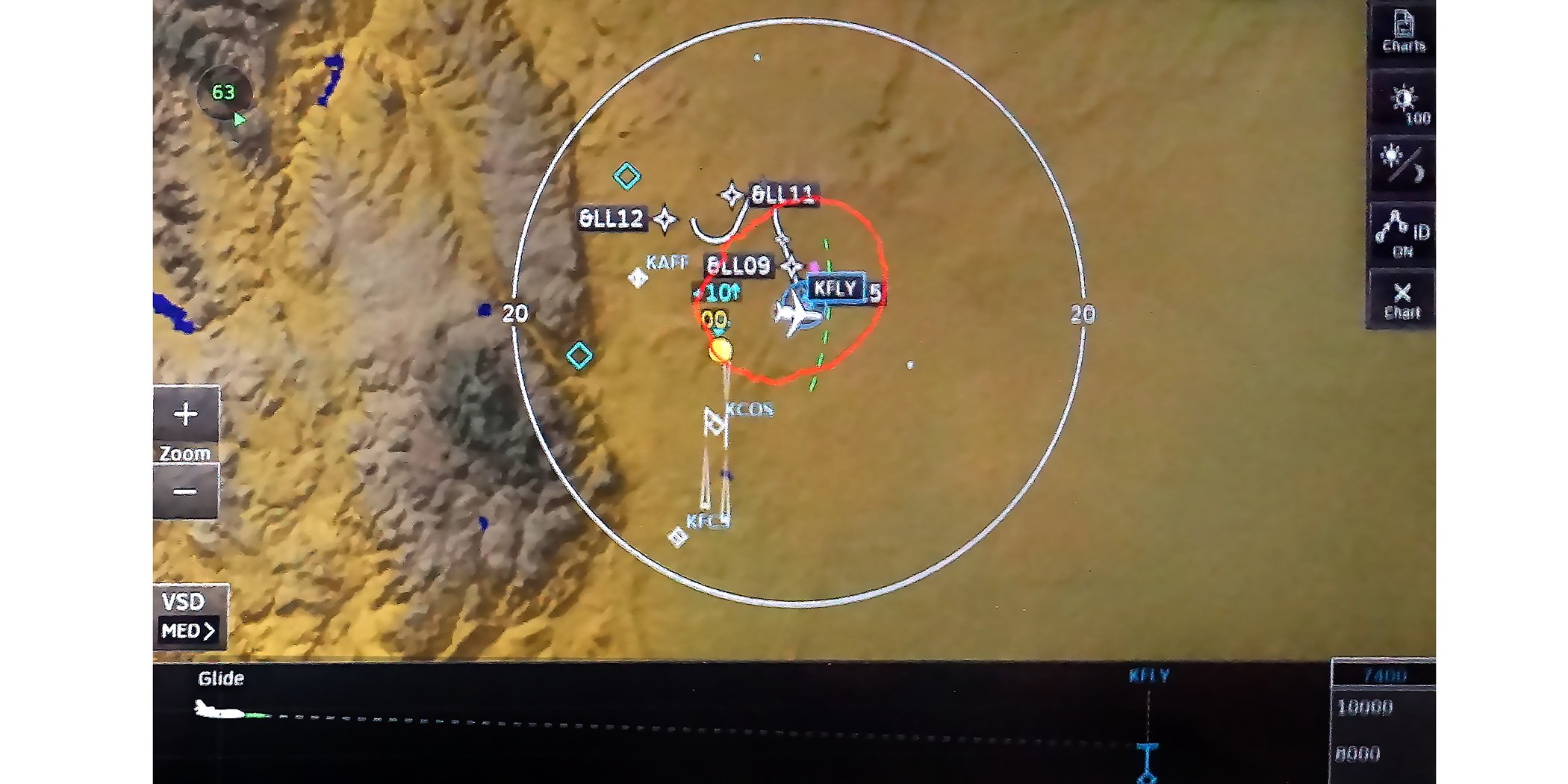Click Here to View This Page on Production Frontend
Click Here to Export Node Content
Click Here to View Printer-Friendly Version (Raw Backend)
Note: front-end display has links to styled print versions.
Content Node ID: 406845
The first question many pilots have when they learn about Honeywell’s new Anthem avionics platform and its cloud-connected capabilities is how avionics with access to the internet can be kept secure. Anthem doesn’t just let pilots share data via the internet but also runs a browser on flight deck displays so pilots can access some of their favorite software while in the air and connected to the internet.
To answer this question and learn more about Anthem, I visited Honeywell’s Deer Valley avionics lab in Phoenix. Inside the lab, engineers have Anthem running on a fixed-base simulator using X-Plane for the flight model and visual display. Honeywell pilots also have been flying Anthem hardware and software in the company’s Pilatus PC-12 since June 2021.
Anthem was the result of a name search that began in February 2020. “We didn’t want to use ‘NG’ or “Epic 2.0,’” said Vipul Gupta, Honeywell's v-p and general manager of avionics. “We wanted to signify something new.”
The team also didn’t favor numbers or a convoluted name and looked for something that signified capability and strength while also allowing aircraft manufacturers to use the term in their description of a customized avionics package based on Anthem. For example, “Fastjet Future Flightdeck powered by Honeywell Anthem.” Nearly 400 names were considered and tested before Anthem won the nod.
Honeywell’s current product lines span light aircraft using Honeywell BendixKing products through Apex in turboprops and Epic-based systems for business jets, airliners, and military aircraft. But Anthem is designed to be a universal platform, affordable and available for all sizes of aircraft.
This is a significant move for Honeywell, which never had a universal avionics system that pilots could start learning during initial flight training and then encounter as they graduate to more sophisticated aircraft. Garmin has grabbed significant market share through its G1000, G3000, and G5000 avionics platforms, which share user interface conventions and are installed in piston singles to business jets. Anthem is Honeywell’s opportunity to create a similar avionics ecosystem—an interface that pilots will learn and grow with throughout their careers.
Several aircraft manufacturers have seen Anthem and are discussing it with Honeywell. Thus far, two companies have committed to incorporating Anthem avionics in their aircraft: Lilium and Vertical Aerospace. Notably, both are electric aircraft developers.
Preflight Planning
Before powering up the aircraft, pilots can plan the flight and set up the flight deck offline with Honeywell Forge on their smart device from anywhere—including at home, in a hotel room, or in the FBO. An onboard gateway or secure onboard server on the aircraft stores information such as tire pressure and other systems information and photos from aircraft cameras. The pilot can view this information remotely, for example, to arrange for a tire fill before heading to the airport, or looking at camera images to ensure there have been no security breaches.
The gateway is also used for avionics database and software updates, but pilots can also reconfigure the flight deck displays remotely via Honeywell Forge so avionics are in the preferred configuration, saving time having to set up the displays in the aircraft. “What we're doing with this offboard app,” explained Honeywell Anthem product line director Jason Bialek, “is we’re telling the cloud what I want in view when I power up the avionics. We're not controlling the avionics, we're just sending out a file that says when the avionics power up, this is what I want to see."

“Only trusted actors are able to access what was saved on that gateway,” he explained. Honeywell uses multiple layers of encryption for access to the secure onboard server. And while Honeywell describes Anthem as “cloud-connected,” he added, “that doesn't mean that we're running the avionics from the cloud.” It just refers to the ability for trusted users to access information from the secure onboard server and for the server to access data when the aircraft is connected to the internet, whether in the air or on the ground.
How the aircraft connects to the internet varies, ranging from VHF to cellular to air-to-ground systems (Gogo, SmartSky) to satcom. “It doesn’t matter to us what that pipe is,” Bialek said.
In the simulator, the configuration includes three touch display units (TDUs), one on each side acting as a primary flight display (PFD) and one in the center as a multifunction display (MFD). Below the MFD is a pilot interface display unit (PIDU), which acts more like a touch controller and a display unit, although all of the displays are touchscreens. The PIDU’s touch features can control the TDUs, even if a TDU's touch layer should fail.
One design element that makes perfect sense is how the flight mode annunciator (FMA) indications are combined with autopilot switches on the top of the PFD. Because it is a touchscreen, the FMA doubles as indicators and switches, so the pilot can make autopilot selections right on the display instead of having to look and reach elsewhere for a traditional guidance panel. This gives the pilot instant feedback on the selection of an autopilot mode, but at the same time is right where the pilot should be looking. A separate guidance panel screen is also available, if needed.
Secure Cockpit Browser
With avionics switched on and in the desired configuration as specified remotely via Forge, the pilot might want to view information from some favorite apps. Honeywell has moved away from developing its own apps that duplicate popular software in favor of allowing those apps into the Honeywell Anthem playground.
These third-party applications run on Honeywell’s Secure Cockpit Browser (SCB), which is basically in a window on the center TDU. Almost any web application can run on the SCB—for example, web versions of ForeFlight, Windy, Universal Weather, and NOAA weather, as well as FAA weather camera feeds and company manuals and documents.
The advantage here is that pilots can access these applications whenever the aircraft is connected to the internet, right on their instrument panel, without having to pull out a tablet and connect it to the internet. “If we’re trying to get into a webpage to do things like put passengers or a manifest in or get permits,” Bialek said, “you can use all of that just like you were using a laptop in the pilot lounge.”
Pilots can pre-configure which applications are quickly available in tabs in the SCB window using the Forge app. Switching to a different web application is simply a matter of touching one of the tabs.

There is a cautionary note on top of the SCB window when it’s running, something that the FAA will probably require, warning pilots that “EFB Window information is advisory only. Do not use for navigation or planning.”
Anthem in the Air
Honeywell has incorporated full taxi guidance into Anthem’s Taxi Assist, with both the 3D and 2D views that are currently available in some Honeywell-equipped business jets, as well as step-by-step routing. Using the touchscreen on the center TDU, the pilot selects the destination on the airport, then once ground control issues a taxi clearance, the pilot can add those instructions to the taxi route and see that guidance on the synthetic vision system (SVS) displayed on the PFD.
Crossing runways are clearly shown with a virtual hold short line symbol that appears like a 3D gate, and when the pilot inputs a hold short clearance, a magenta line blocks entry to the runway as well. During taxi, only the groundspeed is shown, replacing the airspeed tape, which isn’t needed for ground operations.
Once lined up for takeoff, the PFD initially shows ground speed as well as V1 and V2 speeds, still in the taxi mode exocentric view (from above) on the SVS, and this fades and becomes the airspeed tape once the airplane accelerates. The view also shifts to egocentric (from the flight deck) at the same time.
Bialek demonstrated what happens during a rejected takeoff. The view switches back to exocentric and a donut-like symbol appears on (or off) the runway showing where the aircraft should stop given the current conditions.
Once in the air, Anthem has a position trend vector that indicates where the aircraft will end up, for example, while turning and taking wind into account. Traffic is displayed on both the moving map on the center TDU and also on the PFD, but a new feature with Anthem is that the PFD depiction is conformal.
A traffic target is shown tethered to the ground, making it easier to interpret the target’s location and distance, using the distance markers on the SVS. Because the target is conformal, the pilot can use the flight path vector (FPV) on the PFD to ensure clearance; if the FPV isn’t pointed at the target, then there won’t be a collision.
Anthem includes envelope protection features such as automatic engagement of the autothrottles if the airplane gets too slow and the pilot fails to advance power; power reduction if speed becomes too high; a visual indicator when bank is too steep, along with tactile feedback to guide the pilot back to a lower bank angle; and in extreme pitch attitudes, the SVS reverts to blue-over-brown to simplify the display, with arrows to show the pilot where the horizon sits.
Waypoints depicted on the conformal SVS are also tethered to the ground and are called “3D waypoints.” The distance markers again make it easy for the pilot to see a 3D waypoint’s location, instead of looking at the moving map or a waypoint list in the flight plan.

The conformality also helps improve situational awareness because the pilot can immediately see how the aircraft relates to a waypoint or other element. For example, if the pilot gets off course, just by looking at the heading display on the PFD horizon line and the location of the 3D waypoint, the pilot gets instant information about how to get back on course: simply look at the waypoint and see what heading on the horizon lines up with the waypoint.
A waypoint can provide more information about altitude constraints. An “at or above” constraint is depicted as the top half of the waypoint being dim, for example. In the demo, Bialek showed how the pilot can see the flight path angle (FPA) needed to intercept a waypoint at the required altitude. Looking at the waypoint, the PFD pitch ladder shows the angle.
To endure the airplane can make that restriction at that waypoint, he pulled the thrust to idle and watched the energy-based thrust cue caret drop below the FPA, which means the airplane won’t accelerate while descending to that waypoint. The same is true when climbing, say, to an altitude-constrained waypoint, using the caret to show whether there is enough excess thrust available or if the airplane will slow down by trying to climb steeper. “I have immediate visibility of my energy state,” he said.
Another new feature is autosyncing of the heading bug, which many pilots will likely appreciate.
Anthem’s SVS depicts the flight-planned route as a magenta line but overlaid on the terrain. Waypoints are tethered to the ground and conformal, so the waypoint symbol looks like it’s a tethered balloon floating in the air. When nearing a waypoint, this looks a little strange at first, because in the SVS view the aircraft is turning over the point on the ground, not over the floating waypoint. Once you get used to this, it starts to look more normal.
With the magenta line along the ground, it’s easy to see misalignment with the centerline dots that extend from the end of a runway while on final approach.
Another interesting feature will help pilots deal with partial power loss or engine failure by painting a glide range ring on the moving map to show how far the airplane can fly. It is shown on the PFD as a red line in the distance. On the vertical situation display, airports available for landing are shown within the limits of the range ring as well as the altitude the airplane will be at when it reaches those airports.

The final version of Anthem will have a reference pitch line for engine-out guidance, according to Bialek. “If you don’t pitch over early enough, the autopilot will engage and pitch down to that best glide on its own.”
Mission Manager
The Mission Manager is at the heart of Anthem, giving pilots a simple timeline depiction of all the events for a flight. But there is more to it. Honeywell will likely allow pilots to adjust Mission Manager to show the timeline from departure to destination from top to bottom or vice versa.
It can be expanded from a simple flight plan with route elements like departure, airways, and destination or showing all elements and waypoints. But helpfully, Mission Manager shows the number of minutes to each event instead of what most flight planning systems show: the time of arrival at each event. “This is not meant to be a waypoint list,” Bialek explained. “It's a time-based view of what's next.”
Even more helpful is that checklists are integrated with Mission Manager because, after all, they are events on the timeline too. So when it is appropriate for a checklist to appear, say the pre-landing checklist, it will be an event on the timeline. Touching that event brings up the checklist.
Pilots will also be able to set triggers that appear in the timeline—for example, if ATC issues an instruction to contact the tower five miles from the airport, that trigger will automatically pop up a reminder for the pilot at that point.
Mission Manager, Bialek said, “is single-click access to whatever you need to do. It organizes your mission. Even for lower-experienced pilots who aren't yet familiar with the aircraft, all you have to do is look at the icons and you can do a lot of the sequence. But it’s not forcing you into a particular sequence.”
When connected to the internet, pilots can also send and receive information via Forge—for example, a notification to the company’s dispatchers about the aircraft’s location. Or the dispatcher could send a message to the pilots.
“Say the director of operations messages that Eagle County is closed, but it looks like you’re still headed there,” he said. The dispatcher can also send an updated flight plan and “review FP” pops up; then the pilot can choose to activate the revised flight plan. There is none of the FMS-CDU button-pushing required as on most business jets and airliners.
Likewise, warning, caution, and advisory messages on the PFD are shared via Forge, so dispatchers and maintainers can quickly see any problems at the same time as the pilots. “This is an example of cloud-connectivity and why that matters to our customers,” Bialek said.
“[Mission Manager] is a good description of what we intend to do with it. We don't want to distract pilots with all these extra tasks. So you set a lot of this stuff up ahead of time, and then you're able to not be distracted during the mission. It’s a good copilot and mentor,” delivering relevant information that the pilot needs at the right time.
With Anthem, Honeywell is attempting to break new ground in avionics design and the pilot-machine interface, with the goal of making pilots’ jobs easier and safer. However, it remains to be seen how cloud-connectivity will be accepted by pilots and what new capabilities this level of integration can bring to flight decks.